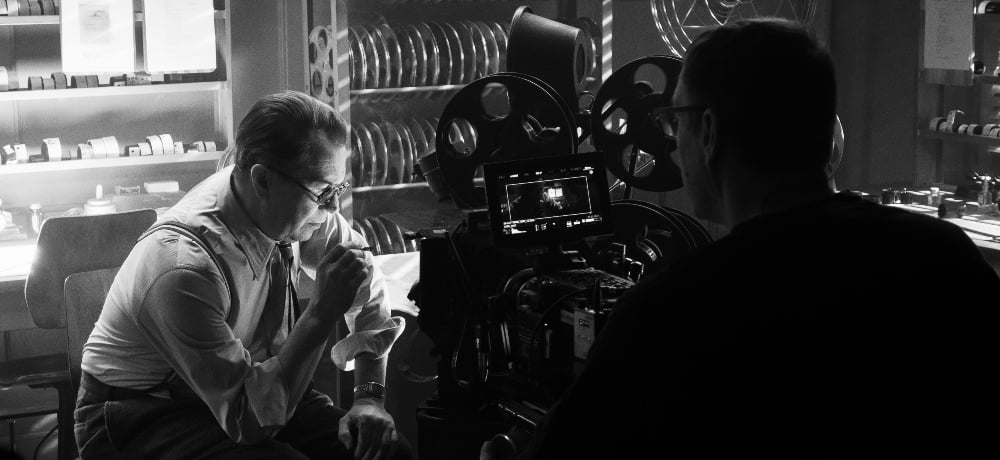


Stanley Donen’s Charade has been described as “the best Hitchcock movie that Hitchcock never made.” A similar phrase could be used for David Fincher’s Mank. You could say it’s a masterful work that Frank Capra never made, that Edmund Goulding never made, or William Wyler never made. It’s a film that captures a particular era of filmmaking so accurately that it looks and sounds like a film by directors of the 1930s and ’40s. So much so that it almost feels unnatural to be watching it on Netflix when it’s clearly a reel of celluloid best presented in an old picture house or even promoted as a newly restored print that plays on TCM every Sunday. Many writers and directors are keen to create a reimagining of this time in film history—project their ideas and dreams of what it should have been like. Fincher isn’t interested in that. He shows how it was. But it’s also not that straightforward—it’s a re-evaluation. Specifically, through the eyes of washed-out alcoholic journalist turned screenwriter Herman J. Mankiewicz during the time he was writing Citizen Kane. It’s not so much a film about the aforementioned masterpiece, though, but about the Hollywood machine run by the dishonest white (male) elite whose hands were in political pockets. Fincher’s highly anticipated return speaks to current events in its tale about the writing of a magnum opus, and in turn, is also a magnum opus for its writer: Fincher’s late father, Jack Fincher.
Netflix’s take on the classic studio film opens as credits roll onto the screen with a beautiful score by Trent Reznor and Atticus Ross that feels befitting to the era. The most prominent aspect of the film is Erik Messerschmidt’s black and white cinematography, praised as the best of the year, and rightfully so. Making it sound and look as though it were made fresh into the talkie era was a brilliant choice by the filmmaker, completely transporting the audience into Great Depression Hollywood perhaps more so than any other contemporary film before it. What makes it more unique is the care it took to dim the high resolution of 2020 cinematography to a softer, less glossy look. Top it all off with subtle marks to make it look as authentically worn as most classic movie prints, with added cigarette burns that can be spotted at the end of almost every scene. The craftsmanship and attention to detail that went into making it resemble an RKO Radio Pictures release is admirable.
Citizen Kane is more often than not looked upon as a work by one man, and understandably so. Orson Welles (uncannily played by Tom Burke) casts a shadow so great as co-writer, director, and actor that it’s easy to mistake it as a work of his mind and his alone. However, as the film explains, the story of Charles Foster Kane is imbued with Herman “Mank” Mankiewicz’s (Gary Oldman) experiences and relationships in Tinseltown. Suffering a broken leg after a car accident, Mank is bedridden. But with the aid of his secretary, Rita (Lily Collins), he’s able to meet the looming deadline to finish the Citizen Kane script. Throughout the writing process, the film flashes back and forth. Timelines are interwoven together to highlight those who influenced his work, namely newspaper magnate William Randolph Hearst (Charles Dance), and his mistress, actress Marion Davies (Amanda Seyfried). When the lights dim, we’re transported from Mank’s desert respite at the beginning of WW2 to early 1930s Hollywood amid the Great Depression. Studios are ruminating about how to get butts in seats while making pay cuts and letting go of employees. The Hollywood elite is seemingly almost unaffected by the crisis gripping the nation as they attend one of many parties (a visual feast thanks to Jan Pascale’s set design and Trish Summerville’s costume design) held at Hearst Castle—a place where an invite meant you were somebody—while members of the lower classes like grips and electricians who lost their studio jobs are left to beg for money on the street.
This establishment of celebrity is depicted here with the most prominent figures of the era from Mayer to Thalberg to Selznick, and each character in the film is portrayed how classic film fans have read them to be. Oscar-winner Gary Oldman leads as the always hungover, loose cannon Mank, delivering a performance backed by a booming monologue that won’t go unnoticed this Oscar season. The scene-stealer, though, is Seyfried as Davies. She delivers the line, “It blew my wig,” and her performance has the same effect. Her scenes are undoubtedly the best, along with the ones she shares with Oldman, as she portrays the sharp comedienne with the same feisty and infectious energy that she had on the screen.
As Mank illustrates the changing landscape of the film industry with the rise of talkies, it also isn’t shy to discuss the changing political landscape. It’s a very politically charged film, with discussions of socialism, communism, and how Hollywood influences can affect an election. An upcoming election weighs on the characters’ minds, as well as the rise of fascism across the pond under the leadership of an insane little man who’s brainwashing a nation. The way this speaks so closely to what’s been happening this entire year (and even the past four years) won’t go unnoticed by anyone. Especially as Oldman delivers the line, “If you keep telling people something untrue, loud and long enough, they’re apt to believe it.”
Movie Score: 4.5/5